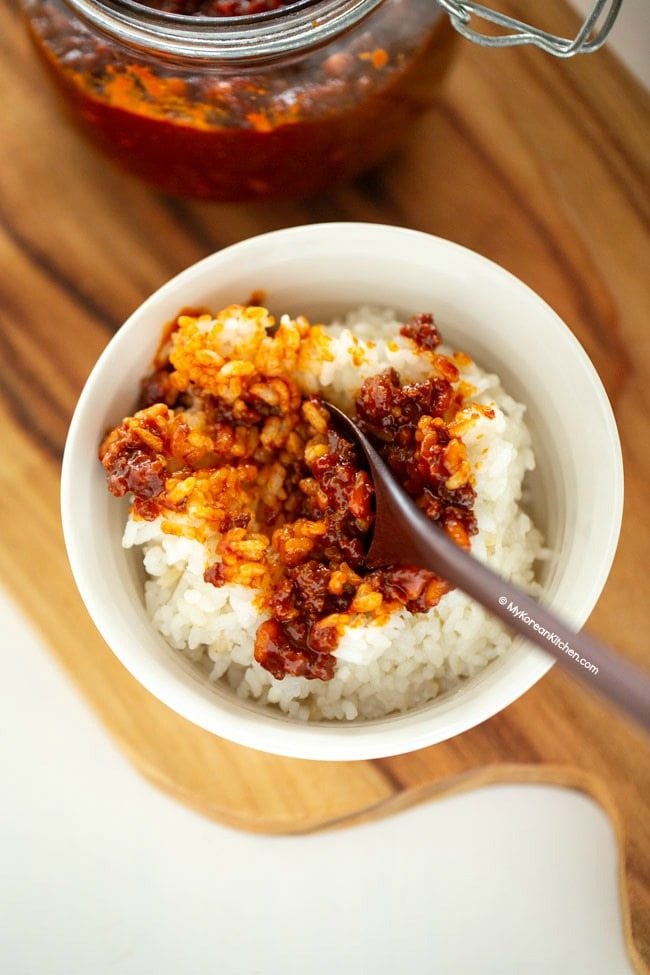Learn to make delicious stir fried gochujang sauce, yak gochujang – a popular condiment perfect for bibimbap and beyond. It’s easy and delightful!
Today, I want to share a magic sauce that will instantly become your favorite condiment: Enter Yak gochujang!
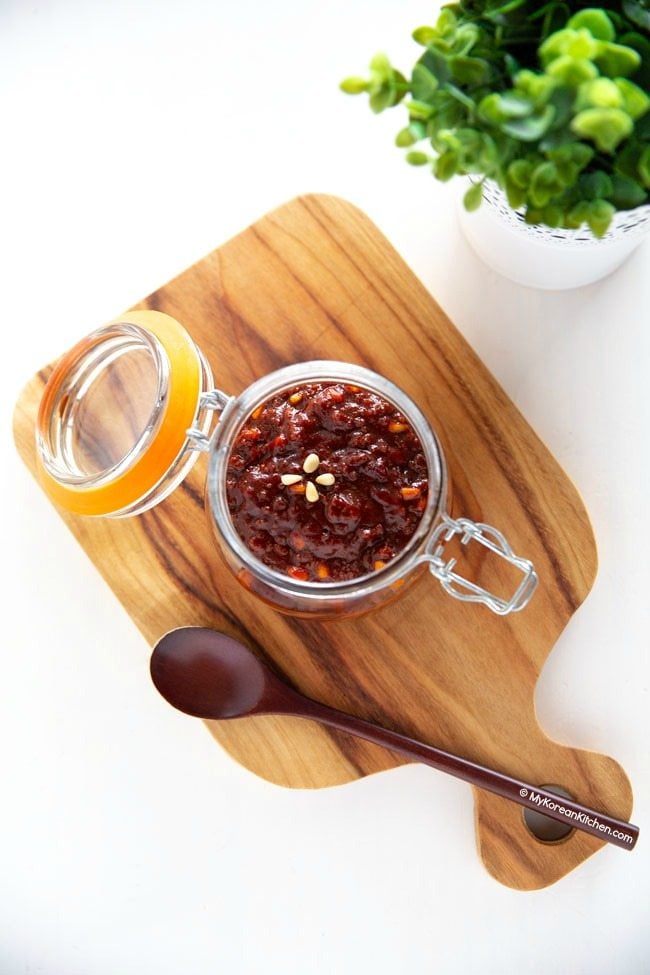
What is Yak Gochujang
Yak gochujang (약 고추장) is a delightful twist on the classic Korean chili paste, gochujang. This stir-fried variation offers a perfect balance of sweet, spicy, and savory flavors, making it an irresistible condiment for your favorite dishes.
Also known as “medicinal gochujang,” yak gochujang gets its unique name from the addition of honey, an ingredient that was historically considered medicinal in ancient Korea.
Due to the cooking techniques used, it can also be referred to as a stir fried gochujang sauce (bokkeun gochujang, 볶은 고추장).
With its rich, complex taste and easy-to-make recipe, yak gochujang is sure to become a staple in your household.
Making Stir Fried Gochujang Sauce
Stir fried gochujang sauce is essentially gochujang that has been cooked in a pan, but its flavor and texture are elevated by incorporating finely minced beef or pork and additional seasonings, such as honey.
The intensity of the sauce’s spiciness can be adjusted by varying the amount of honey you add. For instance, using just 1 tsp of honey will result in a significantly spicier sauce compared to using 1 Tbsp of honey. In the end, it’s up to you to decide just how spicy and sweet you want your sauce to be.
For those who prefer a non-meat option, substituting the meat with mushrooms is a great alternative. In particular, shiitake mushrooms would make an excellent choice for this dish.
Benefits of Having Stir Fried Gochujang Sauce in Your Fridge
The beauty of this gochujang sauce lies in its versatility. Once you’ve prepared a generous batch, it can be stored in the refrigerator for up to a month, ready to serve as a handy, go-to condiment whenever the need arises – essentially becoming your emergency condiment!
In this context, “emergency” refers to those moments when you don’t feel like cooking or you’re feeling lazy. In such cases, you can simply take out this sauce and serve it over some leftover steamed rice. The simplicity of the overall dish depends on how much effort you want to put into preparing additional ingredients.
For instance, in the past few weeks, when I didn’t have much time to cook, I simply served my family steamed rice, fresh salads, eggs, and this sauce in a bowl. This effortless combination resulted in a quick and delightful bibimbap!
What’s more, on days when I feel extra lazy, I just serve the sauce with steamed rice – that’s it. That’s my ultimate lazy lunch. LOL.
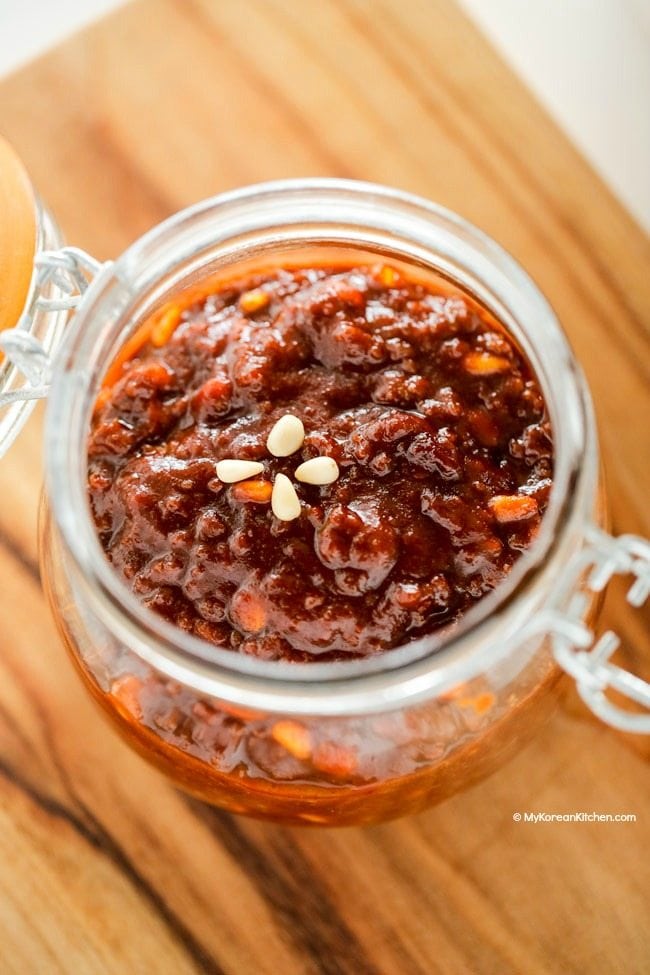
Comparing Stir Fried Gochujang with My Regular Bibimbap Sauce
I know many of you have already tried my bibimbap recipe, which includes my super popular bibimbap sauce (if you haven’t tried it yet, you really should!).
Anyway, I thought it would be interesting to compare my regular bibimbap sauce with this stir-fried gochujang sauce, especially since, as I mentioned earlier, today’s gochujang sauce can also be used as a bibimbap sauce. Just in case you’re curious!
So, my regular bibimbap sauce is thinner and more runny than today’s stir fried gochujang sauce, which means it spreads and mixes more easily. It’s also a bit sweeter and tangier (I mean, I did add some vinegar!).
But the most noticeable difference is that today’s recipe has meat in the sauce, while my regular bibimbap sauce doesn’t.
How to Serve Stir Fried Gochujang Sauce
As I’ve mentioned before, you can use this stir fried gochujang sauce in bibimbap.
Since this sauce already contains protein and is seasoned, it makes preparing your bibimbap much faster.
Also, you can use the gochujang sauce as a dipping sauce for ssambap (Korean lettuce and rice wraps). Fun fact: this is how the king of the Joseon dynasty used to enjoy the sauce.
You can also use the sauce as a filling when making rice balls (similar to Japanese onigiri).
So, are you ready to give it a try? I hope I’ve convinced you! Enjoy!
P.S. If you’re a fan of versatile sauces, you might also want to try spicy canned tuna!
Ingredients for Stir Fried Gochujang Sauce (Serves 15 Bibimbap Bowls)
Main
- 200g / 7 ounces minced beef or pork
- 1 tsp sesame oil
- 3/4 cup gochujang (Korean chili paste)
- 3 Tbsp water
- 1 tsp to 1 Tbsp honey
- (optional) 1 Tbsp pine nuts or your choice of nuts
Meat Marinade (Mix these in a bowl)
- 1 tsp soy sauce
- 1 tsp rice wine
- 1 tsp minced garlic
- 1/2 tsp minced ginger
- A few sprinkles ground black pepper
* 1 Tbsp = 15 ml, 1 Cup = 250 ml
** If you want to learn more about Korean ingredients, check essential Korean ingredients list.
How to Make Stir Fried Gochujang Sauce
1. Combine the meat with the marinade sauce and set it aside for about 5 minutes.
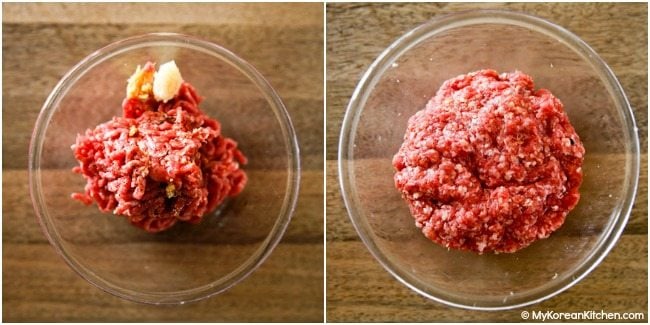
2. Pre heat a skillet over medium high heat. Add the sesame oil and spread it thinly quickly. Add the meat and stir it well so the meat doesn’t clump.
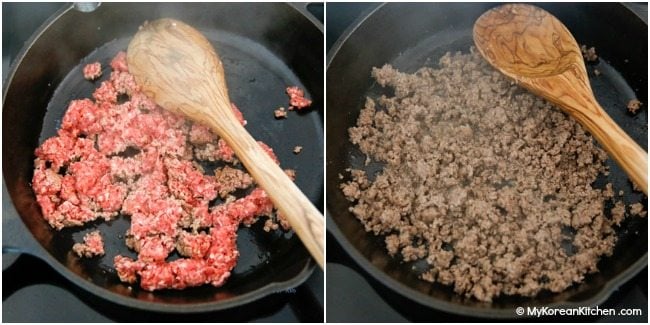
3. Once the meat is mostly cooked, add the gochujang and water. Stir them well for 2 to 3 mins. Reduce the heat to low and simmer it a further 8 mins. Add the honey and pine nuts then stir. Simmer it a further 2 mins. Remove from the heat. Cool it down and store it in an air tight container until needed. It can be refrigerated for up to one month.
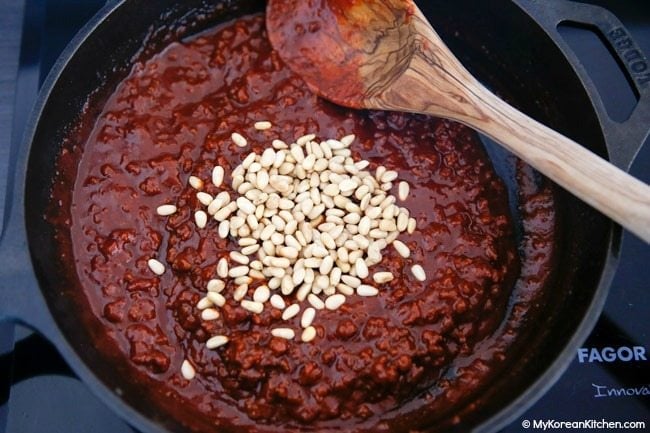
Love Korean food? Browse even more delicious ideas from my collection of easy Korean recipes. Don’t forget to subscribe to my newsletter to stay updated on new recipes, what the MKK community is cooking, and K-Dramas!
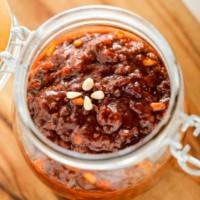
Stir Fried Gochujang Sauce
Ingredients
MAIN
- 200 g minced beef or pork (7 ounces)
- 1 tsp sesame oil
- 3/4 cup gochujang (korean chili paste)
- 3 Tbsp water
- 1 to 3 tsp honey
- 1 Tbsp pine nuts or your choice of nuts (optional)
Instructions
- Combine the meat with the marinade sauce and set it aside for about 5 minutes.
- Pre heat a skillet over medium high heat. Add the sesame oil and spread it thinly quickly. Add the meat and stir it well so the meat doesn’t clump.
- Once the meat is mostly cooked, add the gochujang and water. Stir them well for 2 to 3 mins. Reduce the heat to low and simmer it a further 8 mins. Add the honey and pine nuts then stir. Simmer it a further 2 mins. Remove from the heat. Cool it down and store it in an air tight container until needed. It can be refrigerated for up to one month.
Nutrition Info (per serving)
The nutrition information shown is an estimate provided by an online nutrition calculator. It should not be considered a substitute for a professional nutritionist’s advice.

